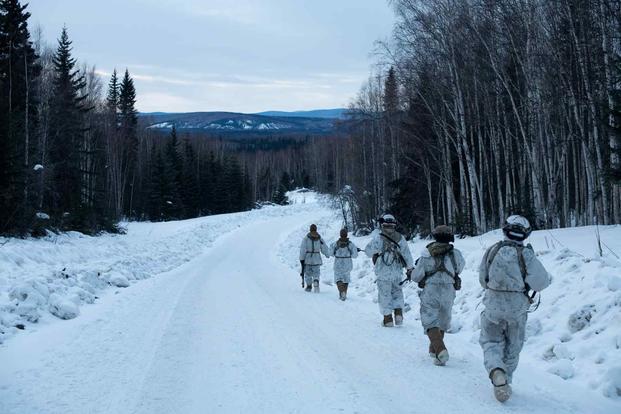Cuts to service members' overseas cost-of-living allowances are coming next month, and some areas are already starting to warn troops about the financial impact it could have on their families.
Some are in for a major hit to their financial bottom line. For example, a specialist in the 11th Airborne Division based out of Alaska with one dependent will lose $129 a month, according to an Army memo reviewed by Military.com. A major with four dependents will lose $464.68 per month.
After delaying the cuts for nearly a year, the Defense Department announced in May that service members stationed overseas, including troops in Alaska and Hawaii, would see cuts to their cost-of-living allowance, called OCOLA, spread out over two separate dates: May 15 and Nov. 15.
Read Next: Soldiers Are Getting Burned Out. Army Leadership Knows It's a Problem.
The second round of cuts will eventually be reflected in Dec. 1 paychecks. More than 230,000 troops receive the stipend overseas.
Troops in Alaska have to deal with especially high costs of living compared to much of the mainland U.S. A number of pay bonuses have been implemented in the past two decades, including the Remote and Austere Conditions Assignment Incentive Pay program, which gives soldiers a one-time payment of up to $4,000.
Since 2020, the Army has paid more than $20 million to soldiers stationed in Alaska.
The nontaxable OCOLA exists to make living in those more expensive areas more affordable for service members by offsetting the cost of daily goods and services, making them comparable to those in the contiguous U.S.
But with rising prices in the U.S. due to inflation, as well as currency fluctuations, the gap has diminished, leading to the cuts. There is also a separate COLA for the highest-cost locations in the continental U.S.
OCOLA is based on a service member's spendable income and does not consider money a spouse earns. It can fluctuate on the exchange rate and can change due to economic situations.
It's calculated by comparing the price of goods and services overseas with the average cost for equivalent products in the States, which creates an index for the cost-of-living allowance. Service members receive an increase only if costs are higher overseas compared to prices stateside, the Pentagon detailed in a May infographic.
There were numerous efforts to delay or ease the cuts prior to the May announcement.
Congress passed a restriction on the DoD cutting the stipends in the fiscal 2023 National Defense Authorization Act, limiting it to once every six months -- instead of potentially monthly like in the past -- in an attempt to lessen sudden blows to service members' wallets.
Military.com reported in March that projected cuts ranging anywhere from 50% to 60% to the cost-of-living allowances for service members and their families stationed in Hawaii and Guam were being delayed.
Senior defense officials said in May that they were allowing combatant commands to protest the changes, but that they must provide data to show that the Pentagon's analysis of prices doesn't accurately reflect the situation on the ground.
Senior defense officials argue that pay increases this year -- such as an across-the-board 4.6% pay raise for troops -- would actually leave service members with more money in their pockets, even accounting for the OCOLA decrease, despite overall living costs having risen rapidly with inflation.
"Even [for] those locations where OCOLA rates will start to decline, pay in 2023 is still higher than it was in 2022," a senior defense official, who spoke on condition of anonymity in May, told Military.com. "So, most service members will still have a higher take-home pay even with OCOLA reductions than what they had in 2022."
-- Thomas Novelly can be reached at thomas.novelly@military.com. Follow him on X @--TomNovelly.
-- Steve Beynon can be reached at Steve.Beynon@military.com. Follow him on X @StevenBeynon.
Related: Pay Cuts for Military Families Overseas Coming This Month as Pentagon Delays Run Out















